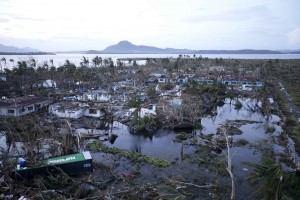Inflation slows down in February but still higher than last year

Tacloban city, devastated by powerful Typhoon Haiyan, is seen in Leyte province, central Philippines. AP FILE PHOTO
MANILA, Philippines—Inflation slowed down marginally in February after hitting a two-year high the previous month as the country gradually recuperated from a supply disruption caused by a recent calamity.
Consumer prices rose at an annualized pace of 4.1 percent in February compared with 4.2 percent in January, the Philippine Statistics Authority (PSA) reported Wednesday.
The latest inflation rate, however, was faster than the 3.4 percent registered in February last year.
Inflation accelerated in January to its fastest pace in two years due mainly to the adverse effects of Super Typhoon Yolanda (Haiyan), which damaged farms, and destroyed public infrastructure and private property in the central Philippines in November.
Officials have said the resulting disruption of agricultural output and business activities in the affected areas caused a spike in overall domestic prices.
But Arsenio Balisacan, director general of the National Economic and Development Authority, said the inflationary impact of the natural calamity had already peaked in January.
Balisacan said the average increase in consumer prices in 2014 was expected to stay within the official target of 3 to 5 percent.
He cited growing investments, including in the manufacturing sector, which are seen to boost supply of goods and services.
The acceleration of inflation to a two-year high in January also came along with the weakening of the peso to its weakest in three years.
The peso had hovered in 45-to-a-dollar territory since the middle of January before strengthening back to the 44 level in the second week of February.
But the Bangko Sentral ng Pilipinas said the calamity was the main cause of the uptick in consumer prices in January. The BSP said the impact of the exchange rate on domestic prices had weakened over the years due to rising production capacity of the economy.
It expects inflation to hit an average within the 4-percent territory this year, still within the official target range of 3 to 5 percent although faster than last year’s average of 3 percent.
The deceleration of inflation in February was driven by the slowdown in the price increments for two groups—alcoholic beverages and tobacco (from 17.6 percent in January to 7.1 percent in February) and transport (from 1.2 percent to 1 percent).
On the contrary, food registered faster inflation of 5.9 percent compared with the previous rate of 5.7 percent.
Other commodity groups that recorded faster inflation in February were the following: clothing and footwear (from 3.4 to 3.7 percent); housing, water, electricity, and gas (from 3.4 to 3.6 percent); furnishing, household and routine maintenance (from 2.6 to 2.8 percent), and health-related items (from 3.2 to 3.3 percent).
RELATED STORY
